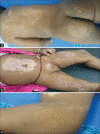Cutaneous Munchausen Syndrome by Proxy: A Diagnostic Challenge for Dermatologist
- PMID: 30505786
- PMCID: PMC6232996
- DOI: 10.4103/idoj.IDOJ_28_18
Cutaneous Munchausen Syndrome by Proxy: A Diagnostic Challenge for Dermatologist
Abstract
Munchausen syndrome by proxy (MSBP) is a rare psychiatric disorder of a caregiver (commonly mother) who induces injury or symptoms on victim because of his or her psychiatry illness. The victims are usually under 6 years of age who cannot complain regarding inflicted injury. Diagnosis is challenging to the physician. We came across a 15-month-old girl child, who had consulted various specialists for episodes of blister followed by erosions on body since 6 months of age. Dermatological examination revealed blisters and healed leaf-shaped scars of different sizes which were suggestive of scalds. Smell of different varieties of oils, dribbling of hot oil from body at various intervals, and mother being the first to notice appearance of new skin lesions in all past episodes lead to suspicion of cutaneous MSBP with mother being the culprit. The family members were counselled regarding nature and course of the condition, mother was started on psychotropics, and the child was rescued from mother along with symptomatic treatment of the skin lesions.
Keywords: Hot oil burn; Munchausen syndrome by proxy; leaf-shaped scars; mother; skin.
Conflict of interest statement
There are no conflicts of interest.
Figures
Similar articles
-
Trichotillomania: Bizzare Patern of Hair Loss at 11-Year-old Girl.Acta Dermatovenerol Croat. 2016 Jun;24(2):150-3. Acta Dermatovenerol Croat. 2016. PMID: 27477178
-
[Munchausen syndrome by proxy].Srp Arh Celok Lek. 2005 Mar-Apr;133(3-4):173-9. doi: 10.2298/sarh0504173j. Srp Arh Celok Lek. 2005. PMID: 16206708 Review. Serbian.
-
Fabricated or induced illness in the oral cavity in children. A systematic review and personal experience.Cent Eur J Immunol. 2015;40(1):109-14. doi: 10.5114/ceji.2015.50842. Epub 2015 Apr 22. Cent Eur J Immunol. 2015. PMID: 26155192 Free PMC article. Review.
-
Alimemazine poisoning as evidence of Munchausen syndrome by proxy: A pediatric case report.Forensic Sci Int. 2016 Sep;266:e18-e22. doi: 10.1016/j.forsciint.2016.08.010. Epub 2016 Aug 11. Forensic Sci Int. 2016. PMID: 27567044
-
Munchausen syndrome by proxy: an experience from Nigeria.Ann Trop Paediatr. 1993;13(3):281-4. doi: 10.1080/02724936.1993.11747660. Ann Trop Paediatr. 1993. PMID: 7505555
Cited by
-
Advancing Understanding of Dermatological Manifestations in Munchausen Syndrome by Proxy.Cureus. 2024 Oct 16;16(10):e71616. doi: 10.7759/cureus.71616. eCollection 2024 Oct. Cureus. 2024. PMID: 39553065 Free PMC article. Review.
-
Diagnostic imaging of child physical abuse: an Indian perspective.Pediatr Radiol. 2024 Nov;54(12):1967-1970. doi: 10.1007/s00247-024-06037-w. Epub 2024 Aug 27. Pediatr Radiol. 2024. PMID: 39187669 No abstract available.
References
-
- Sugandhan S, Gupta S, Khandpur S, Khanna N, Mehta M, Inna P. “Munchausen syndrome by proxy” presenting as battered child syndrome: A report of two cases. Int J Dermatol. 2010;49:679–83. - PubMed
-
- Flaherty EG, Macmillan HL. Committee on Child Abuse and Neglect Caregiver-fabricated illness in a child: A manifestation of child maltreatment. Pediatrics. 2013;132:590–7. - PubMed
-
- Feldman MD, Brown RM. Munchausen by proxy in an international context. Child Abuse Negl. 2002;26:509–24. - PubMed
Publication types
LinkOut - more resources
Full Text Sources
Miscellaneous



